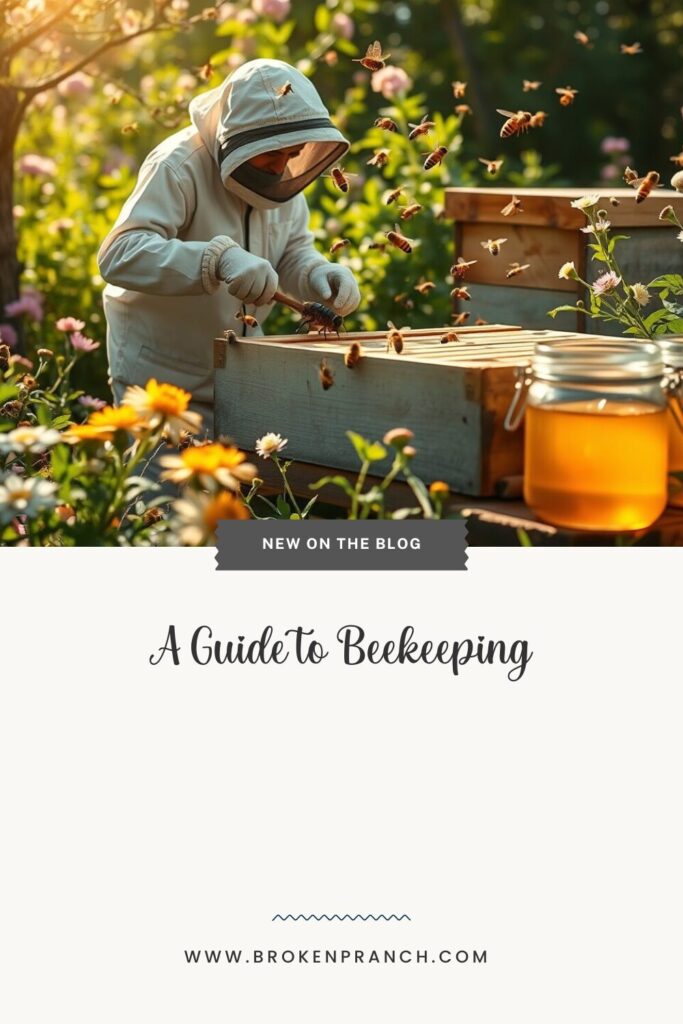A Guide to Starting Beekeeping
There’s something magical about beekeeping. Maybe it’s the golden honey, the soothing hum of a busy hive, or the chance to connect with nature advantageously. Whether you’re dreaming of backyard hives or boosting pollination on your homestead, beekeeping is a beautiful blend of science, stewardship, and sweet rewards.

But let’s be real: starting beekeeping can feel intimidating. You’re dealing with stingers, strange equipment, and buzzing. That’s why this guide exists—to give you a no-nonsense, encouraging path forward. You don’t need a farm or a fancy setup, just curiosity, commitment, and a willingness to learn.
Why Keep Bees?
Before we jump into how to get started, let’s talk about why people fall in love with beekeeping in the first place.
- 🐝 Pollination Powerhouse: Bees boost garden and crop production by pollinating plants. Want better tomatoes, berries, squash, and more? Bees help with that.
- 🍯 Homemade Honey: Harvesting your raw honey is one of beekeeping’s most satisfying (and delicious) parts.
- 🌼 Support Local Ecosystems: Bee populations are in decline. Keeping bees contributes to the health of local ecosystems and food security.
- 🧘♀️ It’s Meditative: Many beekeepers describe it as a peaceful hobby that connects them to nature and slows them down.
What You Need to Know Before You Start
🐝 Beekeeping Is Seasonal
Beekeeping follows the rhythm of the seasons. Spring is all about getting your hive established. Summer brings growth and honey collection. Fall is prep time for winter survival. And in winter? You mostly let your bees be.
📍 Check Local Laws
Before you order your first hive, check your city or county regulations. Some places require permits, inspections, or limit how many hives you can keep.
🐝 You Will Get Stung
Yep. It’s part of the deal. But with the proper clothing and calm movements, stings are rare. Most beekeepers get used to them quickly.
Step 1: Learn the Basics of Bee Biology
Understanding how a hive functions is foundational. Here are the leading players:
- Queen Bee – The only egg-layer. She can lay up to 2,000 eggs per day.
- Worker Bees – All female, they clean, nurse, forage, guard, and more. They do everything!
- Drones – Male bees with one job: mate with the queen. After that, their story ends.
Knowing their roles helps you recognize what’s happening in your hive and what it needs.
Step 2: Gather Your Gear
Here’s your beekeeping starter kit:
🐝 Essential Equipment:
- Beehive (Langstroth is most common for beginners)
- Bee suit and gloves
- Hive tool (for prying apart frames)
- Smoker (calms the bees)
- Bee brush (for gently moving bees off frames)
- Feeder (for giving sugar syrup to new bees)
🐝 Optional but Handy:
- Frame grip
- Queen excluder
- Observation window or hive stand
Step 3: Choose Your Hive Location
If possible, pick a sunny, well-drained spot with morning sun exposure and afternoon shade. Make sure it’s:
- Protected from strong winds
- Far enough from walkways or play areas
- Easy for you to access and maintain
Your bees will travel up to 5 miles to forage, so don’t worry too much about having tons of flowers on-site—but pollinator plants nearby are a bonus!
Step 4: Order Your Bees
You can’t have a hive without bees! You have a few options:
- Package Bees – A box of bees (about 10,000) with a caged queen. Best for new hives.
- Nucleus Colony (Nuc) – A mini hive with frames, brood, and a mated queen. Easier to start with.
- Whole Hive – An established colony (usually bought from another beekeeper).
Order bees from a reputable local supplier in early spring—they often sell out fast!
Step 5: Install Your Bees
This is one of the most exciting days in beekeeping! Once your bees arrive:
- Suit up and light your smoker.
- Prepare the hive by removing a few frames.
- Gently pour or place the bees into the hive.
- Introduce the queen to her cage.
- Close the hive and leave them alone for a few days to settle in.
Step 6: Regular Hive Inspections
Once your colony is established, inspect the hive every 1–2 weeks in spring and early summer. Look for:
- Signs the queen is laying eggs
- Brood pattern (eggs, larvae, capped cells)
- Food stores (honey and pollen)
- Space for the colony to grow
- Signs of disease or pests (like mites)
Take notes after each inspection. It helps you track hive health and learn faster.
Step 7: Harvesting Honey
First-year hives usually need their honey to survive winter, so don’t expect a big harvest immediately. But when it’s time (usually late summer or early fall), here’s how it goes:
- Use a bee brush or escape board to remove bees from the frames
- Uncap the honey cells using a knife or uncapping fork
- Extract honey using a manual or electric extractor
- Strain, jar, and enjoy!
Common Beekeeping Challenges (And How to Handle Them)
🐝 Varroa Mites
These are the most serious threats to bees. Monitor regularly and treat with approved methods, such as formic acid or oxalic acid vapor.
🐝 Swarming
If the hive is too crowded in spring, your bees may swarm. Prevent this with regular inspections, splitting hives, or adding more boxes.
🐝 Queenless Hives
If your hive loses its queen, they may try to make a new one. You can also buy and install a new queen.
Helpful Resources for New Beekeepers
- Books: Beekeeping for Dummies by Howland Blackiston, The Backyard Beekeeper by Kim Flottum
- YouTube Channels: The Beekeeping Mentor, Kaylee Richardson, Barnyard Bees
- Local Clubs: Join a local beekeeping association for mentorship and support
- State Extension Services: Many offer free guides and bee health alerts
Final Buzz: Beekeeping Is a Journey
You don’t have to be an expert on day one. Bees are resilient, nature is wise, and every season brings new lessons. With patience and care, you’ll grow into your role as a beekeeper—and discover just how sweet this life can be.
So grab your smoker, zip up your suit, and get ready to fall in love with the rhythm of the hive. 🐝💛

